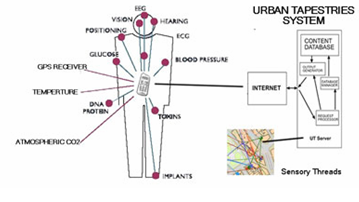|

Project Leader
George Roussos
Researchers
Giles Lane
Alice Angus
Orlagh Woods
Sarah Thelwall
Dikaios Papadogkonas
Keywords
Body sensor networks,
privacy security,
public engagement
|
Sensory Threads
Sensory Threads aims to stimulate and inform a public debate on how personal biosensor data is collected and used in biomedical science. This project will combine an artistic with an evidence-based approach, building and testing a prototype body biosensor network that uploads data to Proboscis’ Urban Tapestries spatial annotation system. This will allow participants to map experiential and emotional annotations to their readings – adding a whole new layer of sentient knowledge to machine data. It is intended to demystify how data is collected, what it produces and how we can correlate it to other factors affecting health such as environmental pollution.
By testing our ideas in real world situations we hope to investigate how empirical data collected from sensor readings attached to the body can be interpreted in a variety of different ways by different disciplines, revealing its limitations for healthcare applications and in the long term for the public. We aim to address the social, cultural, environmental and ethical concerns implied by the reliance on sensor data for understanding the complex interactions between the body and its environment.
Broad and positivist claims have been increasingly made for the role of biosensors in clinical medicine, yet their social and ethical impact is rarely discussed. The long term vision is for biosensors to be used by all to provide 24x7 healthy lifestyle support.
By spatially annotating the sensor readings to the Urban Tapestries public authoring system, participants will be able to visualize tracks of their sensor data and add text, pictures, sounds and even video clips. By allowing them to explore their experiential and emotional responses to wearing the biosensors we hope to learn more about the everyday reactions and implications they pose.

Sensory Threads system.
Sensory Threads aims to address a broad range of issues emerging from the development of biosensors that cross over science, health, engineering, public and corporate policy as well as social and cultural fields. Our research methodology and process will deviate from classic research and development models by focusing on people and social issues at the forefront of the work. It will start with people going about their everyday lives rather than focusing narrowly on technical considerations.
Sensory Threads is fundamentally about people not abstracted ideas of a person's health or populations – Out of the Lab and Onto the Streets!
[1] G. Roussos, S. Maglavera and A. Marsh, 2005, "Enabling Pervasive Computing with Smart Phones", IEEE Pervasive Computing, vol. 4, no. 2, pp. 20-27.
[2] G. Roussos and A. Marsh, 2006, "A Blueprint for Pervasive Self-Care Infrastructures", IEEE Percom 2006 Ubicare Workshop, Pisa, Italy, 15 March 2006.
http://socialtapestries.net/sensorythreads/index.html
|


